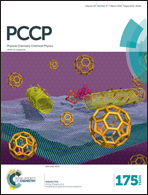Understanding the anion–π interactions with tetraoxacalix[2]arene[2]triazine†
Abstract
Anion–π interaction is a new type of non-covalent interaction. It has attracted growing interest in recent years both theoretically and experimentally. However, the nature of bonding between an anion and an electron-deficient aromatic system has remained elusive. To understand the bonding nature in depth, we have carried out a systematic computational study, using model systems that involve tetraoxacalix[2]arene[2]triazine 1, an electron-deficient macrocyclic host, and four anions, X− (X− = SCN−, NO3−, BF4−, and PF6−), of varied sizes and shapes. The geometries for the 1·X− complexes were optimized using the extended ONIOM (XO) method. The good agreements with the X-ray experimental results provide a validation of our theoretical schemes. The nature of the non-covalent interactions was analyzed with the help of the AIM (atoms in molecules), RDG (reduced density gradient) and LMO-EDA (local molecular orbital-energy decomposition analysis) methods. The results clearly reveal the involvement of anion–π bonding, as well as a weak, yet significant, hydrogen bonding interaction between the benzene C–H on 1 and the anion of NO3− or PF6−. The bonding energies of 1·X− were calculated with the XYG3 functional, and the results were compared with those from MP2, M06-2X and some other functionals with non-covalent interaction corrections (e.g., B3LYP-D3, and ωB97X-D). We conclude that the binding strengths follow the order of 1·NO3− > 1·SCN− > 1·BF4− > 1·PF6−, where the difference between 1·SCN− and 1·BF4− is less significant. The strongest interaction in 1·NO3− comes from: (1) the effective electronic interaction between NO3− and the triazine rings on 1; and (2) the weak hydrogen bonding interaction between the benzene C–H on 1 and nitrate, which cooperates with the anion–π interactions.
![Graphical abstract: Understanding the anion–π interactions with tetraoxacalix[2]arene[2]triazine](/en/Image/Get?imageInfo.ImageType=GA&imageInfo.ImageIdentifier.ManuscriptID=C5CP08065G&imageInfo.ImageIdentifier.Year=2016)

 Please wait while we load your content...
Please wait while we load your content...